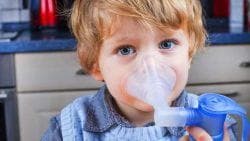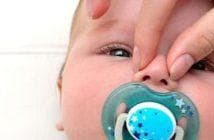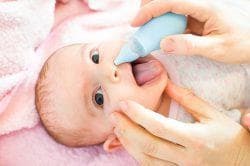
Most moms sooner or later come across the fact that "one day" a child suddenly loses the ability to breathe through the nose. In other words, the nasal passages of the baby simply lay. Most often this occurs after colds or during them.
But sometimes stuffiness can be caused by other causes, far from cold infections. In this article, we will pay attention to this issue and find out why children of different ages have nasal congestion, and how one can get rid of such an unpleasant and life-aggravating symptom.
Content
- 1 reasons
- 1.1 Congenital pathology
- 1.2 Adenoides
- 1.3 Prostudnye infection
- 1.4 Polyps
- 1.5 Rhinitis
- 1.6 Foreign body
- 2 Treatment
- 2.1 vasoconstrictive drops
- 2.2 Irrigation
- 2.3 Inhalation
- 2.4 Warmingointments
- 2.5 Vasodilating drops
- 2.6 Antiviral
- 2.7 Antihistamines
- 3 Features of nasal congestion in infants
- 3.1 Reasons for
- 3.1.1 Formation of the mucosa
- 3.1.2 Cold infections
- 3.1.3 Dryness of the air
- 3.1.4 Overheating
- 3.1.5 Teething Teeth
- 3.1.6 Allergy
- 3.1.7 Congenital pathology
- 3.2 How and what to treat
- 3.3 Not recommended
- 3.1 Reasons for
Reasons for
Let's find out why a child lays a nose.
Congenital pathology

Congenital curvature of the nasal septum or narrowness of the nasal canals sometimes causes a shortness of breath in the child. About this fact, parents become aware soon after the birth of the baby, when he will periodically have problems with nasal breathing.
Often the curvature of the septum leads to the fact that a single nostril can breathe normally, and the second one does not. The pathology data are only surgically removed.
Adenoids
This is the most common cause of nasal congestion in children. Inflamed enlarged tonsils block the passage for air into the nasopharynx, as a result of which the child experiences difficulties with nasal breathing. This problem requires compulsory treatment, because besides obvious inconvenience and discomfort for the child, it also causes oxygen starvation( hypoxia) of the brain. Children with adenoids tend to learn worse, get tired faster, can not concentrate for a long time. What to do when a child has an adenoid and does not breathe through the nose, and what are the best tools, will help understand this article.
Cold infections
Various ARI and ARVI often cause nasal congestion in children. Without fail, this stuffiness will accompany the runny nose. 
Polyps
If a child often has a cold for a long time or has an inflammatory process of the respiratory system, this can lead to benign formation in the nasopharynx - polyps. These formations obstruct passages in the nasopharynx, blocking the access of air. Vasoconstrictors can not help here. But how the polyps are treated in the nose in a child, is described in this article.
Rhinitis
Runny nose is the logical and usual cause of nasal congestion. In this malaise the nasal passages are clogged with crusts and mucus, which prevent the air from passing freely. It is very important to learn how to treat vasomotor rhinitis at home.
Foreign body
It happens that the child puts a small toy detail in his nose, and can not get back any more or forgets. Such a foreign body can cause an inflammatory process, and in addition, completely obstruct the nasal passage. In this case, one nostril does not breathe more often. To extract a foreign body is best for the doctor to exclude the possibility of further deeper "ramming" into the nasal cavity.
On the video - what to do if the child does not breathe a nose:
Treatment
Let's find out how to treat a child's nasal congestion.
First thing to understand is that nasal congestion is not an independent disease, but merely a symptom, albeit very unpleasant, of some kind of ailment or pathology. Show necessarily the child to the doctor: under the professional control treatment will go much more successfully and quickly.
Vasodilating drops

These drugs are applied strictly a limited amount of time. Overdose or infatuation with these drugs, quickly removing the symptoms of stuffiness, will cause a backlash.
That is, the abuse of vasoconstrictors eventually becomes a cause of congestion, and not a method of its treatment.
Washings
Solutions with sea salt sold in a pharmacy( for example, AquaMaris) or self-prepared saline solutions with sea salt will help moisten the baby's mucous spout, and destroy germs. In addition, this procedure helps to remove puffiness, and to stop the inflammatory process.
Inhalation

This procedure can be performed if the child has already turned 2 years old, he has no temperature, and he does not suffer from sinusitis. Inhalations help gently and safely clean the nasal passages from accumulated mucus. In addition, the procedure quickly restores the ability to breathe: as a rule, after the session the child quietly falls asleep, breathing normally. It is best to purchase a nebulizer for this procedure.
And in its absence, a normal saucepan with a warmed broth of herbs, water or boiled potatoes will help. Be careful: it is important that the child does not experience discomfort, and does not get a face burn from hot steam. But how do inhalations with Tonzilgon in a nebulizer for a child and what effect of these procedures can be.will help to understand this information.
Warming Ointments
These remedies are useful if nasal congestion is caused by a cold or subcooling disease. You can use, including, and all known balm "Asterisk".Ointments can be applied to the wings of the nose, the bridge of the nose, even the feet - but only in a small amount.
Vasodilating drops
These remedies also help with nasal congestion. In addition, they can prevent nasal bleeding if the child is exposed to it. 
Antiviral
If the congestion is caused by a viral infection, taking medications that fight this infection will help the child recover faster. The doctor should prescribe the medicine after it has established the cause of the unpleasant symptom. Most often the child is prescribed safe drugs based on interferon protein.
Antihistamines
The administration of these drugs is prescribed in most cases of treatment of congestion. Very often the difficulty of breathing is caused by mucosal edema, with which antihistamines cure.
 Than to treat a strong rhinitis at pregnancy and what means the most effective, will help or assist to understand the given article.
Than to treat a strong rhinitis at pregnancy and what means the most effective, will help or assist to understand the given article.
And here's how to use Albacid in the nose of children and how effective it is, is described in this article.
How much does it cost and what is the instruction of Rinofluimacil to help understand this information: http: //prolor.ru/n/ lechenie-n / rinufluimucil-pri-gajmorite.html
And that's what to do when constantly screaming in the nose, very detailed in this article.
Features of nasal congestion in infants
If a child of an older age has this problem, it causes Mom a lot of anxiety, and the child himself - unpleasant sensations. And if the nose is pawned by the baby, then it is doubly harder to tolerate both the parents and the baby. We'll figure out what causes cause nasal congestion in infants, and how to safely help the child.
On the video - the newborn does not breathe a nose:
Reasons
Formation of the mucosa
The natural period of formation of the mucosa can be accompanied by nasal congestion without objective external causes. Approximately within 2-3 months, after the child is born, all the organs and systems in it come to normal, are finally formed, adapted to external new conditions. Therefore, the nasal mucosa can swell, it is also possible the formation of dry crusts in the nose. 
Catarrhal infections
Although all moms tend to keep an eye on the baby so that the baby does not catch a cold and does not catch the infection, however, it still happens. In this case, the stuffy nose in the baby is necessarily accompanied by a runny nose.
Dryness of air
Often( especially in winter) the air in our apartments is too dry. Working continuously radiators make the microclimate in the room not too suitable for the perception of the tender mucous spout of the baby. As a result of inhalation of such air by the child, the nasal passages dry up, crusts are formed in them, making it difficult for the baby to breathe.
Overheating
Very young children have not yet formed a normal thermoregulation system. As a result of such a natural feature, infants both quickly freeze and quickly overheat, perceiving all external circumstances more sharply. As a result, if you too much to babysit, fearing for his health, you can get the result, which was just afraid.
Teething Teeth
This is a fairly common cause of nasal congestion in infants. During the appearance of teeth, the mucous membranes of the oral cavity and the nasopharynx become swollen, which can easily cause difficulty breathing. In addition, during this period immunity weakens, and the child can more likely "get" an infectious virus disease. 
Allergy
Even a "brand new" person may well have an allergy. This feature of the body causes swelling of the mucous membranes, resulting in nasal passages may be blocked. Typical allergens:
- pet hair;
- home dust;
- washing powders( check how you wash the child's clothes);
- medications, new products at the beginning of complementary feeding.
Congenital pathology
Sometimes a baby's nasal septum is curved from birth, or the nasal passages are severely narrowed. Although these anomalies are not so common, however, they can not be completely excluded. But just to establish this fact can only a doctor, after a detailed examination of the child.
How and what to treat
We learn, by what methods and means it is possible to help the baby again to breathe "full breast".
You should definitely show the child to a specialist who, after the examination, will appoint a treatment appropriate for the case.
If congestion is caused by acute respiratory viral infection, it is usual for the child to have vasoconstrictive drops. Now there is a large selection of various soft-impact drugs that will quickly and safely help the child, and restore his ability to breathe through the nose.
It is important to monitor the humidity in the room where the child is. Buy an air humidifier, and the problem may be solved by itself.
On the video - what to do when a newborn does not breathe a nose:
In case of a child having an allergy, taking antihistamines is necessary. The doctor must prescribe the medicine. And you need a complete or maximum possible exclusion from the life of the baby contact with the allergen-pathogen.
Not recommended.
. What are the ways of treating congestion in children are not acceptable.
You can not clean the baby's nasal passages with cotton buds. These hygiene devices can injure the delicate mucous membrane, and even disrupt the normal growth and development of the nasal passages.
If you do salt saline solutions for washing yourself, do not overdo salt concentration. The correct proportion is: a liter of water / a teaspoon of salt. And no more. Do not think that the more salt, the sooner the recovery will come. On the contrary, a strongly saline solution can burn the mucous membranes of the nose, dry them.
When treating infants, do not use aerosols. Strong pressure of liquid medicine can drive it into the middle ear, and from there and to the auditory tube not far. In this way, fluid that enters the internal auditory organs may eventually cause otitis media.
Burying droplets in the child's nose, do not put a pipette too deep into the nasal passage to avoid injuring the mucous membrane.
We examined the peculiarities of nasal congestion in children. Unfortunately, this most vulnerable part of the population is not insured for any of the diseases: and a runny nose is not the worst thing that can happen. However, this is not an excuse to relax, and not take action: stagnation requires compulsory treatment, and eliminating its cause.
